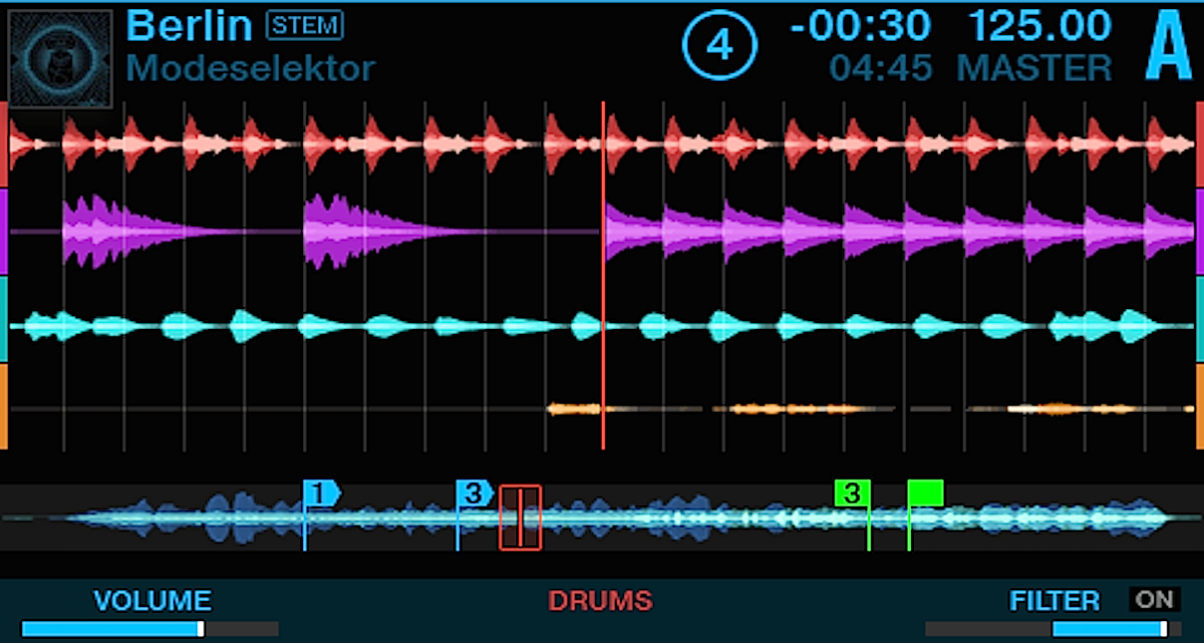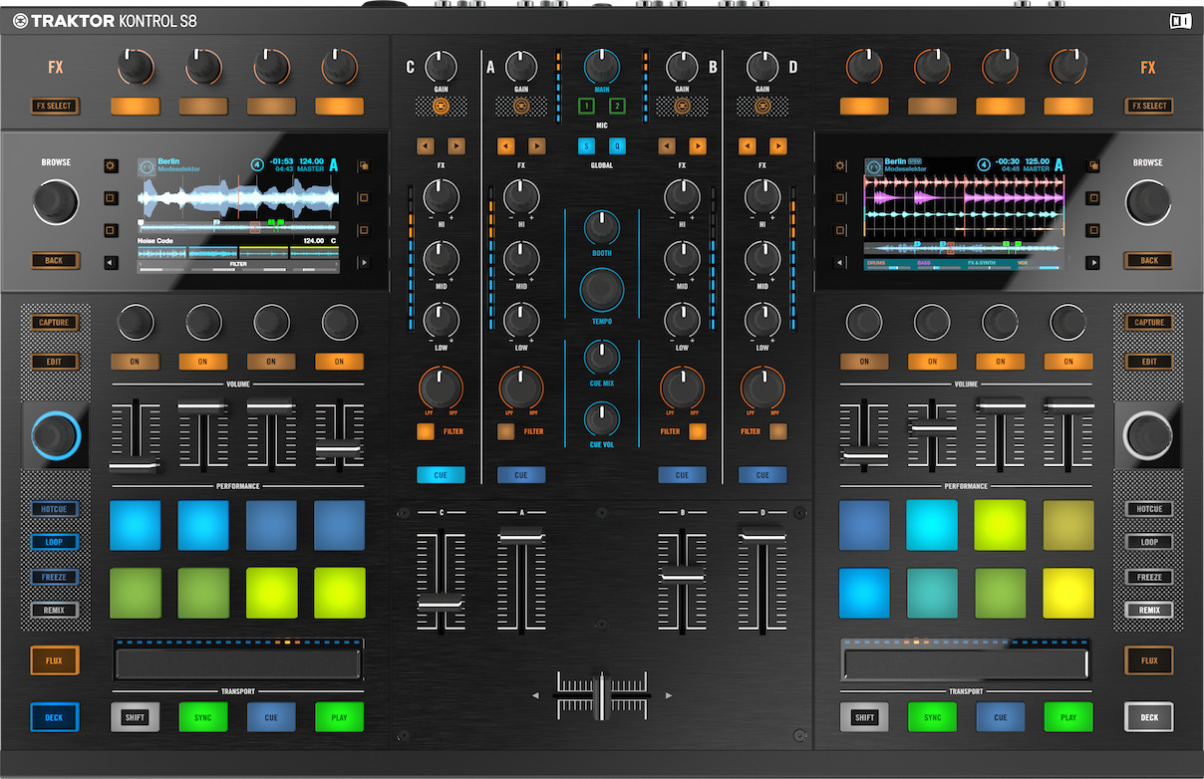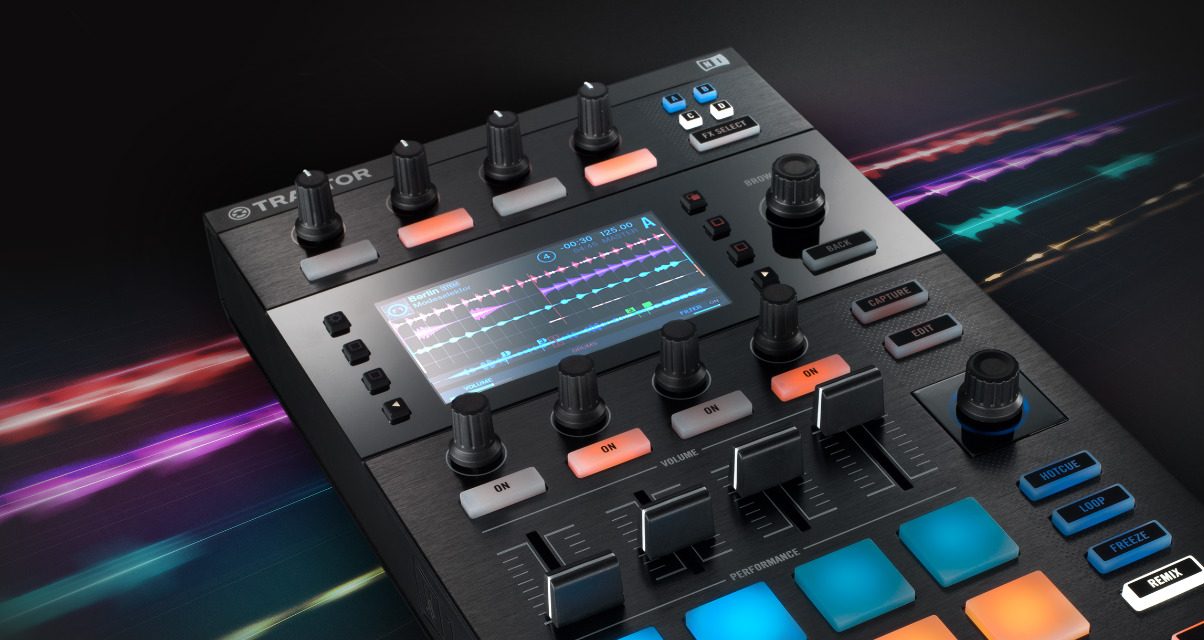The Lowdown
A great idea, well executed and with the potential to succeed.The big question is whether this open-source DJ file format can gain traction both with other hardware / software manufacturers and with the music world. We hope it does.
Video Review
First Impressions / Setting up
Stems is an audio file format developed by Native Instruments for DJs. With compatible DJ hardware and software, Stems files give the user independent control over four parts of a track (for instance drums, bass, synth and vocal). The DJ can adjust the volumes of each part individually, and apply filters and FX too. While Stems officially launches today, we’ve been playing with the hardware and software for a few weeks, and so today offer you a full and complete review, including two talkthrough videos.
More about Stems
The file format “wrapper” is MP4. As well as each of the four separate parts of the track, it also contains a full stereo mix. That means that Stems files behave just like MP3s, in that you can download, audition, play and transfer them among all your devices, and play them back just like you would any other music file (assuming your devices can play MP4, which most modern music software and hardware can). It’s only when you load a Stems file into compatible DJ software / hardware that it becomes more than a “normal” music file.

At launch, Native Instruments has promised hundreds of files available from many labels across a whole host of online retailers, but clearly the hope is that when the Stems Creator Tool becomes available later this summer, that number will swell as producers big and small start mixing their tracks down into this format for DJs to use.
It’s also important to note that this is an open-source platform, meaning Native Instruments is giving it free to any software or hardware makers who wish to use it: There’s no licensing or restrictions on it. The clear desire is that it will be adopted by the wider community and become an accepted and established new file format.
When we first heard about Stems, we were excited in a way which truth be told we struggled to be with Remix Decks, the last attempt at changing how DJs play from Native Instruments. While Remix Decks are certainly powerful and interesting, we ultimately found them unintuitive and over-complicated, with large preparation involved and a lot of concentration while DJing not to mess your performance up.
Frankly, Stems couldn’t be more different. The file appear just like normal music files, and even when loaded onto hardware/software that can play them properly, everything is pretty much immediately intuitive. So to set up, you just plug a controller that works with Stems (currently, the Traktor Kontrol S8, Traktor Kontrol D2, and Traktor Kontrol F1) into a laptop running the new Traktor 2.9, load a Stems file onto a deck, and move the four faders for that deck to control the volumes. The first impression is, basically, that a child could work out how these work in seconds… and to us, that’s exactly the kind of thing you want when DJing.
In Use
So from a creative point of view, they’re great fun right from the off. You can get instant acapellas, instant instrumentals, and so on. Want an instant dub mix? Then you can add a long post-fade echo to a vocal, strip the track back to drums and bassline, and flick in the odd word or sentence from the full song – done!
The fun really starts, though, when you are mixing with a bunch of Stems files. It is ridiculously easy to swap the beat from one song for that from another, for instance. Get a couple of songs in compatible keys, and the same goes for basslines or vocals. If you want to extend the length of a mix over minutes not seconds, it’s suddenly simple to swap the beats over while leaving the rest of a song playing, so when you finally switch melody from one to the next, the beat has already “won over” your crowd.

When you start combining ideas like the above with loops, cues and so on, and it becomes extremely addictive. But here’s the important thing: It never becomes overwhelming. Ultimately, I think the reason for that is that temporally, the tracks play as they were intended. You simply can’t, for instance, decide to loop just the bassline, or just the vocal, like you can in Remix Decks; when it comes to where you actually are in a track, it’s one place and one place alone. This keeps it simple enough to understand at all times. (You can of course turn off all the other elements, but they’re still “looping” in the background.)
And if you do get “out of your depth”, by simple disengaging the master effect, returning all filters to 12 o’clock, and pushing the four faders for the deck to maximum, you’re back with the full, unaltered stereo mix. Because of the confidence this gives you, you find yourself not feeling the need to really “plan” ahead; an idea comes to you “in the mix”, and you can do it spontaneously. Sounds a lot like DJing as we know and love it, to us…
However your results will vary depending on the hardware you use with Stems, as there are differences depending on what you’ve got plugged in. So let’s take a closer look at how Stems work on the various hardware that is enabled to use them from launch:
With the Traktor Kontrol S8 & D2
These are the best controllers to use Stems with. The Kontrol S8 is an all-in-one controller with two decks and a mixer, and the Kontrol D2 is simply one of the decks from a Kontrol S8 without a second deck or mixer. If you wanted to add Stems capabilities to an existing Traktor system (ie a Kontrol S2 or a Kontrol S4, or even a controller by another company that you currently use with Traktor), the D2 would be one of the ways to go.

With these controllers, the on-board controller screen shows you four separate, colour-coded waveforms, so you can easily see what’s coming up in each section of the track. It’s important to note that the laptop display in Traktor looks like any normal file, so you do need to look at the controller screens to get this info. The four short faders on the deck you’re using control the volume of each section, while the transport controls (play/pause, cue etc) work exactly as they would for any music files, as do things like looping, cues, Flux etc.
The on-board screen also shows a waveform of the whole track, although this is obscured when you engage filters or FX, as a “slide up” menu appears to show you your settings for those functions. Tap the button top-right of the screen and the four waveforms merge into one and basic info from the “other” deck appears.
The four knobs above the four faders by default control individual filters for each of the four stems, just like the “main” filters on each channel on most Traktor controllers. The buttons for each knob turn the filters on and off. The buttons bottom-left and bottom-right of each onboard screen toggle this behaviour between filters and FX.
When you toggle to FX, whatever effect/effect combo you have assigned to the channel as a whole works across all four stems (so you can only have one for everything), but in this instance, the four knobs become individual FX wet/dry controls. That means, for instance, you could have an echo on just the vocals, leaving the rest of the music “clean” of FX, which opens up a myriad of creative potential, while keeping it simple at the same time.
Talking specifically about the D2 for a second, while it is possible to control more than one deck with a single D2, it is not practical, and so for Stem-on-Stem mixing, you would definitely want two of the units. Combining them with a Kontrol Z2 mixer (which adds the necessary audio interface) would give you more or less a complete modular version of the S8.
With the Traktor Kontrol F1
It’s quite interesting what Native Instruments has done retro-fitting Stems to the Traktor Kontrol F1. First intended for Remix Decks, we suspect lots of these are sat around under-utilised, and so these little controllers are going to be an easy (read cheap / no cost) way to play with Stems for quite a few Traktor users.

As the F1 has no screen to show you the individual stems (and as stated earlier, Traktor’s laptop display also doesn’t have any Stems information on it), Native Instruments has instead programmed the 4×4 LED grid to flash in four vertical VU meters, showing you the loudness of each individual Stem. It’s actually pretty smart, because while you can’t see the same detail as on the S8 and D2 screens, you can see enough to show you which of the stems has stuff going on on it and which hasn’t. Taken in combination with the main waveform on your laptop screen, this means you’re not running “blind”, not by any means.
As you might expect, the four faders on the unit do the same as those on the S8 and D2 decks, although this time there are also mute/solo buttons for each fader, making use of the buttons that were already there. The four knobs you’d expect to control the filters do just that, but the FX control is more limited here; a modifier button plus any of the four grid buttons that subsequently light allows you to send that chosen stem to the currently selected FX engine for the channel as a whole – but that’s all the control you get.
Worth pointing out too that as, of course, the software doesn’t know which deck you want to use the F1 with, there is an easy way of choosing one of the four decks. While this means in theory you could use one controller to control four Stems decks, you’re going to really want at least two for Stem-on-Stem mixing.
Conclusion
Stems are very promising indeed. They’re a genuine innovation, they’re fun, and they put blue water between software DJing and the old ways. Crucially, they do so without ultimately cutting the cord to what most people feel DJing to be about. Unlike the Remix Decks, I honestly don’t think lots of DJs on playing with these will DJs scratch their heads and pass up. Indeed, even initially dubious DJs who we’ve shown Stems to in our studio have gone away really excited about them.
Stems files work better on the D2 and S8 than the F1, although the F1 has a valiant attempt and is still usable. Traktor 3.0 will surely build in on-screen displays that mean the F1, and indeed any Midi-mapped hardware, can be much more usable with Stems, which will help their adoption.

One thing that we thought time and time again when playing with the limited number of Stems files that Native Instruments provided us with in order to prepare our reviews, previews and talkthroughs, was: “If this is fun now, how much fun is it going to be with music everyone genuinely knows and loves?”
And that brings us on to the big question: Will this format catch on? Stems files cost more than normal files, and they are bigger, too. And clearly, not all music is going to be released in this format, at least not immediately. Yet the success of Stems as a whole is going to rely on producers, labels and online stores getting behind the format big time.
Native Instruments has done the right thing making the complete project open source, including access to the Stems Creator Tool needed to mix down a completed production to a Stems file. This is the right way to encourage others to get on board, and indeed Beatport has already announced that Beatport Pro works with Stems, allowing buyers and users of the Mac library app of the same name to preview the stems within such files directly, away from Traktor.
It’s a bigger leap to imagining the likes of Serato and Rekordbox at some point in the future having compatibility built in, although you never know – the market may force it. But don’t forget Virtual DJ, too, a software with millions of users and a company not scared to get involved with third-part innovations; of the three names just mentioned, I’d think Virtual DJ would be the most likely to announce compatibility.
So to conclude, Stems is bold and brave and the whole idea is great fun. Native now has to work very hard on getting everyone on board. Really, the Stems Creator Tool should have been available right now to everyone, and the company would do well to rush that out. From there, it ought to put a lot of resources into making sure the majority of the big tunes at any given time are also released in a Stems version alongside the usual MP3 and WAV.
If Native Instruments can break its back to manage that admittedly big task as soon as humanly possible, I think the DJ community will then adopt the format enthusiastically, giving Stems a bright future. The format deserves to succeed, because it’s great fun, frankly verging on genius. But time will tell…




